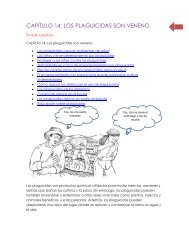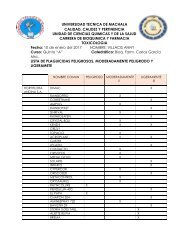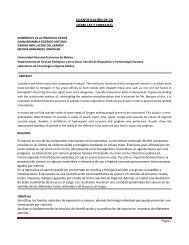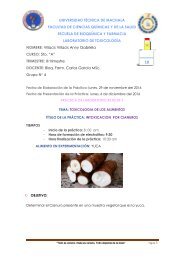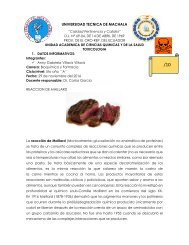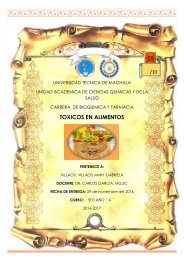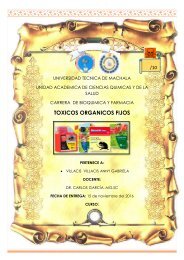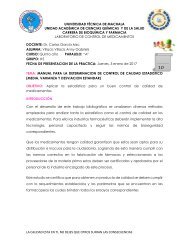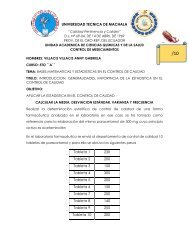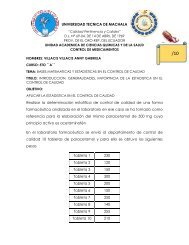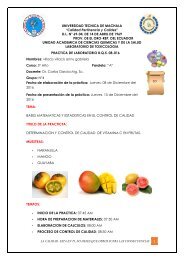You also want an ePaper? Increase the reach of your titles
YUMPU automatically turns print PDFs into web optimized ePapers that Google loves.
36 Junqueira et al.<br />
Saccharides are non-digestible materials that<br />
reach the large intestine (CAMPBELL et al., 1997;<br />
GIBSON; ROBERFROID, 1995; KIRIYAMA et al.,<br />
1992; LE BLAY et al., 1999a and b; MORTENSEN<br />
et al., 1988; PIVA et al., 1996; RISLEY et al., 1992),<br />
but only certain saccharides are able to stimulate<br />
butyrate production at that location (CAMPBELL<br />
et al., 1997; LE BLAY et al., 1999a and b;<br />
MORTENSEN et al., 1988). Gluconic acid is<br />
fermented in the large intestine (ASANO et al.,<br />
1997), but the fermentation process induced by this<br />
acid has not been elucidated.<br />
Sodium gluconate is commonly used in human<br />
food industry as an acidifier, coagulant and carrier<br />
for mineral supplements (ASANO et al., 1994).<br />
Only two experiments have been performed to test<br />
the effects of sodium gluconate on broilers (GUO<br />
et al., 2009; RAFACZ-LIVINGSTON et al., 2005b),<br />
and the conclusion was that the addition of sodium<br />
gluconate in diet caused an increase in weight gain<br />
and tibia ash of starter broilers.<br />
The objective of this experiment was to evaluate<br />
the effect of sodium gluconate on performance (feed<br />
intake, body weight, weight gain, feed conversion,<br />
livability and productive efficiency), carcass<br />
characteristics (carcass, breast, thigh and drumstick,<br />
wing and back yield), and morphometry of<br />
duodenum, jejunum and ileum of broilers from 22<br />
to 42 days of age.<br />
Material and methods<br />
A total of 1,200 Cobb male broilers were housed<br />
from 1 day of age in a completely randomized<br />
design, with 5 treatments (5 levels of sodium<br />
gluconate: 0.00, 0.10, 0.20, 0.30, and 0.40%) and 8<br />
replications of 30 birds each. The broilers were<br />
vaccinated against Marek disease, Newcastle disease<br />
and Infectious Bronchitis at hatchery. The<br />
immunization against Gumboro and Newcastle<br />
diseases was done at 7 days of age, and the<br />
reinforcement against Gumboro disease at 14 days<br />
of age. The room temperature recorded during the<br />
experimental period was 27 ± 2.8ºC, and relative<br />
humidity was 78 ± 8.7%.<br />
Water and feed were provided ad libitum. Broilers<br />
were fed with common starter diet until 21 days of age,<br />
in accordance with the nutrient recommendations<br />
(3,005 kcal ME kg -1 and 21.6% of CP) of Rostagno<br />
et al. (2005). The broilers were weighed at 22 days of<br />
age, and then allocated according to weight in 40 boxes<br />
containing 30 birds each.<br />
The basal diet (Table 1) was formulated<br />
following Rostagno et al. (2005) recommendations.<br />
Broilers were housed over reused wood-shavings<br />
bedding to provide a sanitary challenge.<br />
Body weight and feed intake values were recorded.<br />
Weight gain, feed conversion, livability, and productive<br />
efficiency {PE = [Daily mean weight gain (g) x livability<br />
(%)] / (feed conversion x 10)} were calculated for each<br />
pen at 42 days of age. The yield evaluation was done<br />
using 8 broilers per replication selected at random.<br />
Table 1. Composition and nutritive values of basal diet.<br />
Ingredients %<br />
Corn 66.48<br />
Soybean meal 25.78<br />
Soybean oil 3.03<br />
Dicalcium phosphate 1.63<br />
Limestone 0.96<br />
L-Lysine-HCl (78%) 0.27<br />
DL-Methionine 0.20<br />
L-Threonine 0.11<br />
L- Arginine 0.06<br />
L-Valine 0.09<br />
L-Isoleucine 0.05<br />
Vitamin and mineral premix 1 0.50<br />
Salt 0.44<br />
Variable portion (sand) 2 0.40<br />
Total 100.00<br />
Calculated nutrients<br />
CP (%) 17.76<br />
ME (kcal kg -1 ) 3,175<br />
Calcium (%) 0.87<br />
Sodium (%) 0.21<br />
Total Phosphorus (%) 0.63<br />
Available Phosphorus (%) 0.41<br />
Digestible Lysine (%) 1.07<br />
Digestible Methionine (%) 0.47<br />
Digestible TSSA 3 (%) 0.77<br />
Digestible Tryptophan (%) 0.18<br />
Digestible Threonine (%) 0.69<br />
Digestible Arginine (%) 1.13<br />
Digestible Valine (%) 0.82<br />
Digestible Isoleucine (%) 0.72<br />
1 Vitamin-mineral premix supplied the following per kilogram of feed: vitamin A (8,000<br />
IU), vitamin D 3 (1,800 IU), vitamin E (12 mg), vitamin K 3 (2 mg), vitamin B 1 (1 mg),<br />
vitamin B 2 (4 mg), vitamin B 6 (1 mg), vitamin B 12 (10 mcg), folic acid (0.40 mg), biotin<br />
(0.04 mg), niacin (28 mg), calcium pantothenate (11 mg), copper (6 mg), cobalt (0.10<br />
mg), iodine (1 mg), iron (50 mg), manganese (65 mg), zinc (45 mg), selenium (0.21<br />
mg), choline chloride 50% (500 mg), coccidiostat (60 mg), ethoxyquin (antioxidant) (12<br />
mg). 2 Variable portion: consists of variable amounts of sand and sodium gluconate<br />
containing the levels of 0.00, 0.10, 0.20, 0.30, and 0.40% sodium gluconate. 3 TSAA =<br />
total sulfur amino acids (methionine + cystine).<br />
At 42 days of age, the broilers were submitted to<br />
a 6h pre-slaughter fast, after which they were<br />
weighed individually, slaughtered and eviscerated.<br />
The yield was obtained from the entire carcass yield<br />
(without feet, head and neck), breast yield, thigh and<br />
drumstick yield, back yield and wing yield.<br />
The morphometric analysis of the intestinal<br />
mucosa (duodenum, jejunum and ileum) was done in<br />
samples collected from two birds per replication.<br />
Samples measuring 1 cm were collected from the<br />
duodenum, jejunum and ileum. The duodenum<br />
sample was collected at the apex of this intestinal<br />
portion, the jejunum at the midway portion between<br />
the point of entry of the bill ducts and Meckel’s<br />
diverticulum, and the ileum 10 cm before the cecal<br />
junction. The intestinal segments were fixed in Bouin's<br />
Acta Scientiarum. Animal Sciences Maringá, v. 34, n. 1, p. 35-40, Jan.-Mar., 2012






